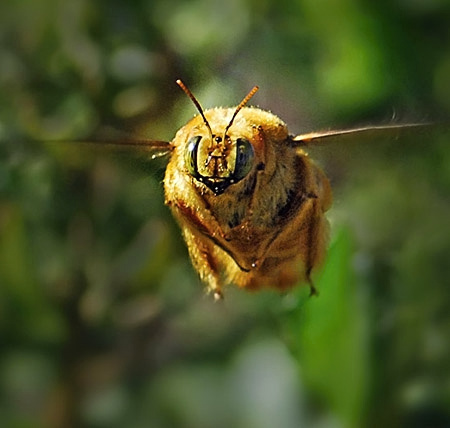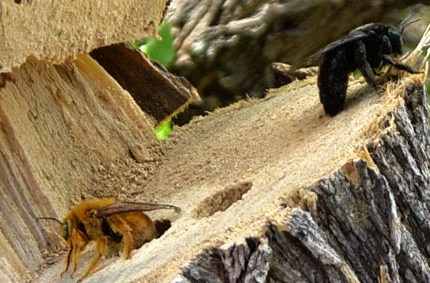Orange bumblebee? A hornet/bee hybrid? Giant flying peanut?
Many metaphors describe the bumbling buzzer known as the valley carpenter bee, the largest native bee that’s currently lollygagging through many SoCal gardens, outdoor locales and parklands. Who hasn’t experienced one of these fast-flying furries zooming straight toward your face? Who hasn’t responded with an unconscious head duck, possible panic and maybe even a shriek of terror?

But let them be screams of delight, not fear, says University of California, Berkeley entomologist Gordon Frankie. He calls them “sweet teddy bears. They are such nice gentle bees and fun to watch.”
Frankie has been studying native bees in California for 15+ years and is one of the authors of “California Bees and Blooms: A Guide for Gardeners and Naturalists,” a book that compiles hours of field research into one handy-dandy volume with plenty of color pix.
The marble-sized carpenter bees have relatives around the world from Uganda to Bangladesh, Thailand to Costa Rica – but here in SoCal, the valley carpenter bee reigns supreme.
Frankie’s would love the day when people embrace bee watching as easy and enthusiastically as they do bird watching. After all, SoCal has plenty bees to watch here – California is home to more than 1,600 species of native bees. Honeybees? That’s just one of many. And they aren’t even native.
With birdwatching, it’s easy to hook beginner birders with easy-to-find large birds, like egrets, Canada geese, hawks, etc. In that vein, beginning bee-watchers could get captivated by the sight of a carpenter bee rambling about sages, salvias or any of the numerous ornamentals they fancy. “They have a wide range of host plants they go to,” says Frankie. “They especially love French lavender.”
But differences separate the birds from the bees. Bees give you the heebie jeebies? Frankie dispels them all.
- “I’m going to get stung!”
Ah yes…the stinging. It’s rare, but if you are stung by a carpenter bee, it was from a female since males have no stinging equipment. Females are shiny black while males are yellowish-orange, appearing as if they were rolled in a giant cache of pollen.
And if you were one of the few to be stung, you probably were provoking her, says Frankie. Simple as that. “Carpenter bees are only looking for three things: pollen, nectar and mates. Humans and stinging are not on their list.”

- “They’re going to ruin my house!”
The carpenter moniker comes from the fact these buzzers chew holes and tunnels in wood to lay eggs, a habit that can cause home and business owners unmerited freakout-ness. Sometimes they will reuse a nest, but often they opt to create new nurseries. They have been known to congregate with others on a particularly appealing wooden area, especially on the underside of house eaves.
“There’s never been a case of a home coming down because of carpenter bees,” reassures Frankie. If multiple bees are setting up multiple nurseries in your building, save your money and don’t call the exterminator. “Just plug the holes with steel wool. They will go and find another place for their eggs.”
To further encourage bees away from your home, try a diversion tactic. Leave out an old piece of wood away from your house for bees to roost. Or install a simple bee house which keeps them happy and away from your property.

- “They will swarm!”
Carpenter bees lead solitary lives, content with their own company and that of their next flower stop. They don’t have a hive mentality like honeybees. If you see more than one on a host plant, it’s not because they want to be together, you just have one very tasty source for nectar and pollen. They, like Greta Garbo, would rather be alone.
- “They are creepy.”
Well, if that’s your attitude, Frankie can’t help you. But he has a trick that does seem to turn around minds and hearts.
When he gives educational talks about native bees, Frankie often brings along male carpenter bees that have been placed in a minor state of suspension via a cold fridge. He puts the groggy bees in a volunteers’ cupped hands. As the confused bee starts waking up and moving around, giggles and squeals take over. Eventually, the hand is opened and the bee flies off albeit somewhat lumbering.
The happy look from the volunteer (“I held a bee! A furry bee!”) surely translates into a new appreciation for the giant bee, says Frankie. “Bees and the land have evolved together, they need each other,” he says. “Together, they are the whole show.”

